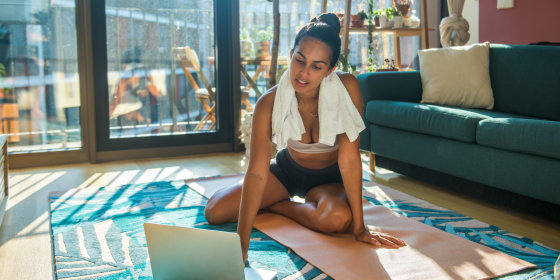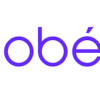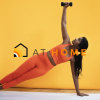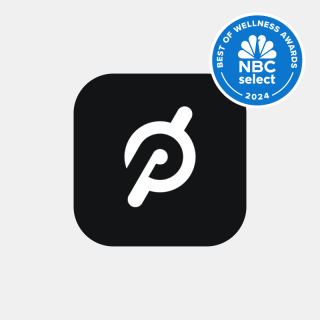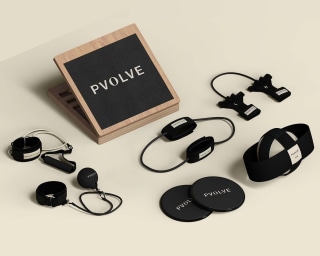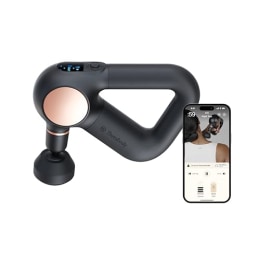While working out, it’s important to have a routine, or, something to follow that guides you through exercises and toward your health goals. If you don’t have a personal trainer or experience putting programs together, a fitness app is one of the best places to start, says Ansley Davis, a master trainer and yoga teacher at YogaSix. These apps are virtual libraries with hundreds of workout classes, and they do all of the planning for you — just press play and follow the trainer on your screen.
“The guidance will give you results a lot quicker than trying to do it all on your own,” says Kendra Thomas, a yoga and strength instructor who teaches at fitness studios in New York City. Fitness apps also give you the flexibility to exercise whenever you want, wherever you are — you’re not tied to a schedule, so you can do a class at any point in your day, whether you’re at home, the gym or even in a hotel.
If you’re interested in signing up for a fitness app, I spoke to experts about what to think about while comparing different options. The NBC Select staff and I also tested over a dozen fitness apps (including some that are free) to share our top picks.
Want more from NBC Select? Sign up for our newsletter, The Selection, and shop smarter.
How I picked the best fitness apps
While deciding which fitness app to sign up for, experts recommend thinking through the following factors, all of which I took into consideration while creating our list of favorites.
- Your fitness goals: Before browsing fitness apps, consider what you want to accomplish through your workouts, be it improving strength or adding more movement to your life. Some fitness apps let users follow specified paths that gradually increase in level, giving you the opportunity to advance in whatever area you choose.
- Exercise types: If you want access to various types of exercise, like strength training, Pilates, HIIT and yoga, experts say it’s best to go with an app that has a mix of classes. On the other hand, if you’re interested in focusing on one specific type of exercise, it’s best to go with a specialized app, like one that centers around barre classes, for example.
- Class lengths: Most fitness apps offer classes of various lengths, letting you choose one based on how much time you have to workout. Classes can be five minutes to one hour long. You can also stack shorter classes on top of one another to build a longer workout.
- Modality: There’s two class modalities available through fitness apps: live and on-demand. Live classes require you to log on to an app at a certain time for a livestream with a trainer, while on-demand classes are pre-recorded and always accessible through the app’s library. Not all apps livestream classes, but they all have an on-demand library — if live classes are important to you, be sure to look for them before signing up for an app. Also, keep in mind that fitness apps with live classes record them and add them to their on-demand libraries, which lets you do the class on your own schedule.
- Required equipment: Many fitness apps have classes where no equipment is required, but having a set of dumbbells, ankle weights, resistance bands and similar accessories expands the pool of programs you can choose from. If you don’t want to invest in workout gear to keep at home, trainers usually walk you through modifications during classes, or you can use household basics, like paper plates as sliders and tomato sauce jars as dumbbells. People also use fitness apps at gyms that are fully stocked with equipment.
- Tracking progress: Keeping track of data, like what weights you use and how many reps of an exercise you do, makes it easy to understand how much you’re progressing in your fitness goals, says Davis. Some fitness apps automatically keep a log of the classes you take, while others have sections that let you manually input information.
- Cost: Fitness apps usually have monthly and annual payment plans, the latter of which might save you a few dollars, or get you a year of access for the price of 10 months or so. Price varies per app, so think about how much you’d be comfortable spending, and add in the estimated cost of the equipment you might need to invest in, although that’s a one-time cost, says Davis. There’s also a handful of free fitness apps to choose from, and some paid apps offer free versions of their platform with fewer bells and whistles.
- Cancellation policy: Fitness apps often offer a free trial before you have to pay for a subscription, says Davis. Make sure you read the fine print and know when you’ll have to cancel the app if it doesn’t align with your preferences. Once you’re paying for a subscription, it’s worth reading the cancellation policy, too.
The best fitness apps of 2026
All the fitness apps below come recommended by NBC Select staff members or the experts I spoke to. I detailed important information about each option, including the types of exercise they offer and in what modalities, as well as their overall cost and how long their free trials are.
Best overall: Alo Moves
- FSA/HSA funds accepted
- Fitness and wellness classes
- Smooth app experience
- Nothing to note at this time
Alo Moves is the most widely used and highly recommended fitness app among NBC Select’s staff. It has an extensive library of on-demand classes, which you can filter by exercise type, length, skill level and required equipment. Alo Moves also has a selection of wellness classes centered around meditation, nutrition and mindfulness, which is why Rebecca Rodriguez, NBC Select editorial projects manager, says it takes a holistic approach to health. “Alo Moves is the most versatile fitness app I’ve tried with the easiest user experience,” she says. “For the most part, the trainers do a great job of providing clear guidance and instructions, offering descriptive references that help you visualize proper form. Because it’s such a holistic app, I think the $130 annual fee is pretty fair and something I’ll definitely continue paying for.” You can take individual classes at your own pace, or build custom playlists that stack classes so they automatically play in succession. Alo Moves also has pre-built playlists and themed series curated by trainers.
Exercise types: all | Modality: on-demand | Cost: $12.99/month, $129.99/year | Free trial: 14 days
Best live classes: Peloton
- Daily livestream classes
- Can connect heart rate monitor
- Audio-only classes available
- Busy app interface
Peloton is known for its immersive bike, treadmill and rower machines, but you don’t need to own the brand’s workout gear to use its fitness app, which comes recommended by NBC Select editor Lindsay Schneider. Peloton offers various workouts across strength, cardio, flexibility, stretching and meditation, including multiple livestream classes a day. Some of the other fitness apps I recommend also have livestream classes, but Peloton’s are the most frequent and plentiful. It also posts its livestream schedule ahead of time so you can see which classes align with your calendar. Peloton constantly expands its library of on-demand classes, too. Some programs are audio-only, so you can take them while running or walking indoors or on the treadmill. You can connect a heart rate monitor to the app, which displays your metrics on the screen as you exercise.
Exercise types: all | Modality: live and on-demand | Cost: $12.99/month, $129/year | Free trial: 30 days
Best instructors: Obé
I’ve been an Obé member for over two years and to date, I’ve taken over 500 classes on the app. It’s very similar to Alo Moves and Peloton in terms of the variety of classes available in its on-demand library, which is updated daily and split up into four categories: cardio, strength, yoga and activate/recover. While the well-structured workouts themselves make my membership worth it, what really keeps me coming back are the instructors. They’re all cheerful, encouraging and energizing, and they talk me through workouts, so I find it easy to form a connection with them, even through the screen. I’ve learned so much about the benefits of certain types of movement, what different muscle groups do and how to improve my technique while taking Obé’s classes. Using the app has also motivated me to try workouts outside my comfort zone, like those that involve lifting heavy weights.
Obé is catered toward women, but I think anyone can use the app. That said, it touches on women’s health topics in many of its curated programs, like syncing workouts to your menstrual cycle and aging. There’s also pre- and post-natal workouts available. If you’re someone who is new to exercising or has a specific goal in mind, you can take Obé’s quiz, and based on your answers, the app creates a personalized fitness plan for you that refreshes as you go.
Exercise types: all | Modality: on-demand | Cost: $24.99/month, $170/year | Free trial: 7 days
Best free: Nike Training Club App
- Scheduling feature
- Fitness and wellness classes
- Detailed info about classes
- Mostly shorter workouts
Nike Training Club is free to join, which is ideal if you’re already paying for a gym membership but want the guidance and support of classes, or if you don’t have room in your budget for an additional expense. You can choose from nearly any type of workout, and the app has informational videos about mindset, movement, nutrition, recovery and sleep. There’s also a scheduling feature that lets you pre-plan what workouts you want to take each day and set specific times for them — the app sends you a reminder before your scheduled classes, which helps keep you accountable.
“I’m obsessed with the short workouts they have (a ton are 5 or 10-minutes long), and the videos are really crisp and clear,” says Schneider. “I also like that before you start any class, you can quickly find all the relevant information you want, like how long it is, what target areas you’ll hit, whether any equipment is required and what kind of music is played. Every other app that has this many features and workouts costs money, so I can’t sing Nike Training Club’s praises enough.”
Exercise types: all | Modality: on-demand | Cost: free | Free trial: N/A
Best audio-only: Aaptiv
What sets Aaptiv apart from other fitness apps is its library of audio-only workouts, says Thomas, who recommends it. Each one is like a mini podcast that combines instructions from trainers with music that’s paced to exercises. You can choose from workout types like strength training, yoga, HIIT and Pilates, and there’s programs you can do outside, as well as on the treadmill, stairmaster, bike and elliptical machine. Without the video component, you can focus on your form instead of watching someone else, which eliminates distractions, according to the brand. You can choose workouts based on factors like type of exercise, how long you want to exercise for and your favorite trainers or music. There’s also an option to connect a heart rate monitor. Aaptiv exclusively offered audio-only for years, but it now also has video content as well, similar to the other apps on this list.
Exercise types: all | Modality: on-demand | Cost: $14.99/month, $99.99/year | Free trial: 7 days
Best low-impact: Pvolve
- Weekly live classes
- Challenging yet approachable
- Supports daily movement
- Need specialized equipment
Every NBC Select staff member who’s done Pvolve says the same thing: it’s one of the most effective, challenging and enjoyable low-impact workouts they’ve tried. Rodriguez described it as “killer,” which I agree with since I’m sore after every session. The types of exercises you do during classes build off Pilates, barre and sculpt, but Pvolve has its own specific method and format. It pairs movements with its custom resistance-based equipment to further engage your muscles, and many exercises mimic everyday activities like bending, lifting, pulling and reaching. “Pvolve isn’t exactly like any other workout I’ve done before, so there was a slight learning curve,” says Rodriguez. “But it’s easy to pick up quickly since the instructors are fantastic at providing very clear directions.”
Pvolve’s app lets you filter classes by equipment (or lack thereof). But the majority of classes center around its custom resistance-based equipment, which you need to get the full experience, says Rodriguez. You don’t necessarily have to buy the brand’s gliders, dumbbells, ankle weights and resistance bands — those accessories from any brand will do. However, Pvolve’s P.ball, P.band, P.3 Trainer and Precision Mat aren’t comparable to other equipment on the market, so you’d have to invest in it, which is pricey. That said, “for $180 a year, and given the fact that you need to own a lot of the brand’s equipment to make it worthwhile, I would only recommend a membership to someone who is going to be dedicated to the Pvolve method,” says Rodriguez.
Exercise types: sculpt, strength, recovery, meditation | Modality: live and on-demand | Cost: $19.99/month, $179.99/year | Free trial: 14 days
Best yoga: CorePower Yoga
- Daily live classes
- Easy to level up & modify
- FSA/HSA funds accepted
- Nothing to note at this time
CorePower offers live and on-demand classes for every type of yogi, whether you’re someone who likes a slower, quieter flow or one that moves through sequences quickly to get your heart rate up. Some classes also incorporate weights, like Yoga Sculpt (my favorite) and CorePower Strength X, and there’s beginner basics videos, which help users learn fundamental poses. Two people are in almost all of CorePower’s virtual classes: a trainer and a student (or multiple). The student demonstrates how to level up and/or modify exercises, showing me options for customizing each one to my body. I also appreciate the detailed definitions for each class type on the app so I know what I’m getting into before I press play.
Because there’s CorePower studios across the country, the company offers an All Access Membership ($259/month), which gives you unlimited access to in-studio workouts, livestreams and on-demand classes — I’m a CorePower All Access Member since I take classes at least three times a week. You can also get a membership to just the virtual on-demand and livestream classes, which is $19.99 a month.
Exercise types: yoga, strength, stretching | Modality: live and on-demand | Cost: $19.99/month (at-home membership, $259/month (All Access membership) | Free trial: 7 days
Best for women: The Sculpt Society
I’m a Sculpt Society devotee, and every time I use the app, it makes my day better. The classes are some of the most fun workouts I do every week because they’re so engaging and upbeat. I’m always shocked by how much I sweat during and how sore I am afterward. The Sculpt Society’s classes mainly center around dance cardio and sculpt, a type of workout that focuses on toning and shaping specific muscle groups with elements of Pilates and yoga, as well as low weight, high repetition strength training. There’s also traditional strength classes that involve heavier weights available on the app. The Sculpt Society categorizes workouts by level, so you can easily find what’s right for you and advance over time. Plus, there’s new live classes every week, collections of classes for those recovering from injuries and numerous pre- and post-natal classes.
One of my favorite parts of The Sculpt Society app is the ability to comment on classes in a discussion board. You can leave a note to the instructor about what you loved or ask a question. The instructors are active in the chats and give great advice. The discussion boards create a virtual community, which you don’t always get through fitness apps.
Exercise types: sculpt, dance, strength, stretching | Modality: live and on-demand | Cost: $19.99/month, $179.99/year | Free trial: 7 days
Meet our experts
At NBC Select, we work with experts who have specialized knowledge and authority based on relevant training and/or experience. We also ensure that all expert advice and recommendations are made independently and without undisclosed financial conflicts of interest.
- Ansley Davis is a master trainer and yoga teacher at YogaSix.
- Kendra Thomas is a yoga and strength instructor who teaches at fitness studios in New York City.
Why trust NBC Select?
I’m a reporter at NBC Select who has covered fitness for five years at NBC Select, including topics like women’s running shoes, women’s walking shoes, sports bras and at-home dumbbell workouts. To write this article, I interviewed two experts about fitness apps, and tested over a dozen options along with the NBC Select staff.
Catch up on NBC Select’s in-depth coverage of tech and tools, wellness and more, and follow us on Facebook, Instagram, Twitter and TikTok to stay up to date.

